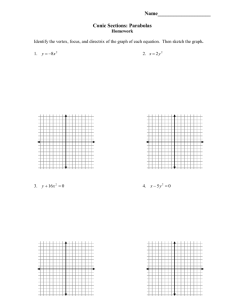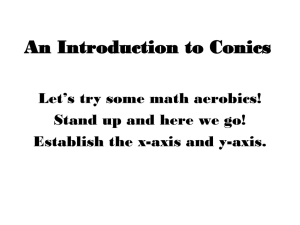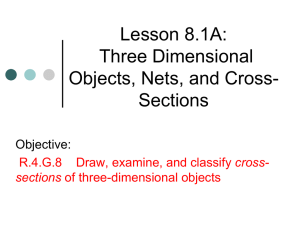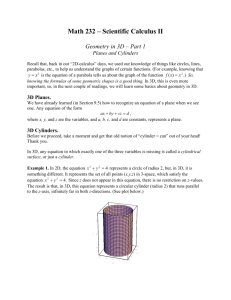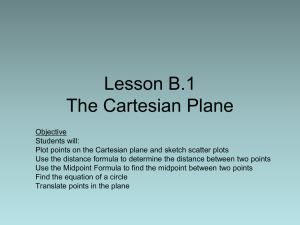File - Conic Sections
advertisement
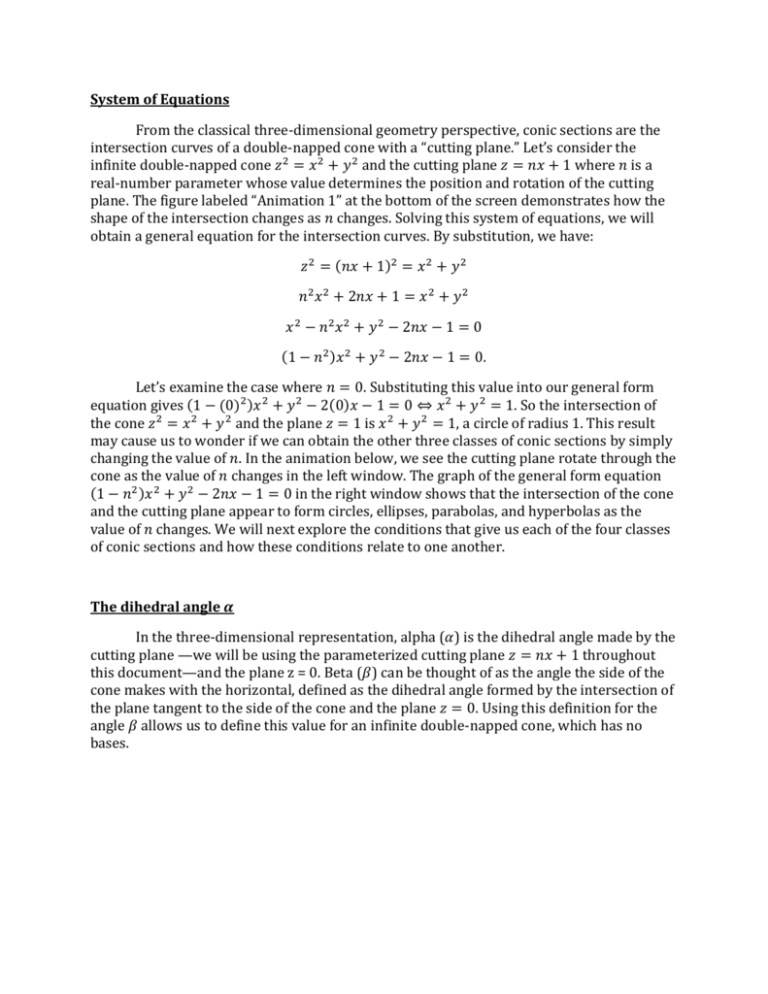
System of Equations From the classical three-dimensional geometry perspective, conic sections are the intersection curves of a double-napped cone with a “cutting plane.” Let’s consider the infinite double-napped cone 𝑧 2 = 𝑥 2 + 𝑦 2 and the cutting plane 𝑧 = 𝑛𝑥 + 1 where 𝑛 is a real-number parameter whose value determines the position and rotation of the cutting plane. The figure labeled “Animation 1” at the bottom of the screen demonstrates how the shape of the intersection changes as 𝑛 changes. Solving this system of equations, we will obtain a general equation for the intersection curves. By substitution, we have: 𝑧 2 = (𝑛𝑥 + 1)2 = 𝑥 2 + 𝑦 2 𝑛2 𝑥 2 + 2𝑛𝑥 + 1 = 𝑥 2 + 𝑦 2 𝑥 2 − 𝑛2 𝑥 2 + 𝑦 2 − 2𝑛𝑥 − 1 = 0 (1 − 𝑛2 )𝑥 2 + 𝑦 2 − 2𝑛𝑥 − 1 = 0. Let’s examine the case where 𝑛 = 0. Substituting this value into our general form equation gives (1 − (0)2 )𝑥 2 + 𝑦 2 − 2(0)𝑥 − 1 = 0 ⇔ 𝑥 2 + 𝑦 2 = 1. So the intersection of the cone 𝑧 2 = 𝑥 2 + 𝑦 2 and the plane 𝑧 = 1 is 𝑥 2 + 𝑦 2 = 1, a circle of radius 1. This result may cause us to wonder if we can obtain the other three classes of conic sections by simply changing the value of 𝑛. In the animation below, we see the cutting plane rotate through the cone as the value of 𝑛 changes in the left window. The graph of the general form equation (1 − 𝑛2 )𝑥 2 + 𝑦 2 − 2𝑛𝑥 − 1 = 0 in the right window shows that the intersection of the cone and the cutting plane appear to form circles, ellipses, parabolas, and hyperbolas as the value of 𝑛 changes. We will next explore the conditions that give us each of the four classes of conic sections and how these conditions relate to one another. The dihedral angle 𝜶 In the three-dimensional representation, alpha (𝛼) is the dihedral angle made by the cutting plane —we will be using the parameterized cutting plane 𝑧 = 𝑛𝑥 + 1 throughout this document—and the plane z = 0. Beta (𝛽) can be thought of as the angle the side of the cone makes with the horizontal, defined as the dihedral angle formed by the intersection of the plane tangent to the side of the cone and the plane 𝑧 = 0. Using this definition for the angle 𝛽 allows us to define this value for an infinite double-napped cone, which has no bases. Double-napped cone (𝑧 2 = 𝑥 2 + 𝑦 2 ) with horizontal plane (z = 0) in blue. Beta 𝛽 is the angle between the horizontal plane, z = 0, and the tangent plane shown in purple. The dihedral angle 𝜃 formed between two planes of the form 𝐴1 𝑥 + 𝐵1 𝑦 + 𝐶1 𝑧 + 𝐷1 = 0 and 𝐴2 𝑥 + 𝐵2 𝑦 + 𝐶2 𝑧 + 𝐷2 = 0 can be described using the dot product of the normal vectors ⟨𝐴1 , 𝐵1 , 𝐶1 ⟩ and⟨𝐴2 , 𝐵2 , 𝐶2 ⟩, generating the following equation: cos(𝜃) = 𝐴1 𝐴2 + 𝐵1 𝐵2 + 𝐶1 𝐶2 √𝐴12 + 𝐵12 + 𝐶12 √𝐴22 + 𝐵22 + 𝐶22 . Rearranging terms, we have the planes 𝑧 = 0 and −𝑛𝑥 + 𝑧 − 1 = 0. In order to obtain a function of 𝑛 that gives the dihedral angle 𝛼 between the planes, we substitute into the formula: cos(𝛼) = (0)(−𝑛) + (0)(0) + (1)(1) √(0)2 + (0)2 + (1)2 √(−𝑛)2 + (0)2 + (1)2 ⇒ cos(𝛼) = ⇒ 𝛼 = cos −1 ( 1 √𝑛2 + 1 1 ). √𝑛2 + 1 As an example, let’s pick 𝑛 = 1. This means that 𝛼 is the dihedral angle formed between the planes 𝑧 = 0 and 𝑧 = 𝑥 + 1. By the formula we just obtained, we have 𝛼 = cos−1 ( 1 1 ) = cos −1 ( ) = 45°. √2 √(1)2 + 1 Since the double-napped cone 𝑧 2 = 𝑥 2 + 𝑦 2 has a radius of |𝑧| for any height 𝑧, it is known that the value of 𝛽 for this cone is 45°. This value can be obtained by calculating the dihedral angles between the planes 𝑧 = 0 and 3𝑥 + 4𝑦 − 5𝑧 = 0, the latter of which being the plane tangent to the surface of the cone at the point (3, 4, 5). Because 𝛼 = 𝛽, the cutting plane is parallel to the tangent plane. This implies that the cutting plane only intersects one nappe of the cone and that the cutting plane must pass through the “base” of the cone, as demonstrated in the animation below. For the infinite double-napped cone we are considering, there is no “base” of the cone for the plane to intersect, but the intersection of the cutting plane and the cone still forms a single, open curve that we expect to be a parabola. We may verify this by solving the system of equations for the intersection of our cone 𝑧 2 = 𝑥 2 + 𝑦 2 and cutting plane 𝑧 = 𝑥 + 1. Substituting 𝑥 + 1 for 𝑧, we obtain: (𝑥 + 1)2 = 𝑥 2 + 𝑦 2 𝑥 2 + 2𝑥 + 1 = 𝑥 2 + 𝑦 2 𝑦 2 = −2𝑥 − 1 1 𝑦 2 = −2 (𝑥 + ). 2 This equation is the standard form equation of a parabola. When 𝛼 < 𝛽, the cutting plane passes completely through the lateral surface of one nappe of the cone, generating a single, closed curve which is an ellipse. When 𝛼 = 0, the cutting plane is parallel to the plane 𝑧 = 0 and the intersection curve is a circle. When 𝑎 > 𝛽, the cutting plane passes through both nappes of the cone, generating two open curves which are the branches of a hyperbola. Plane intersecting a cone creating a circle. Plane intersecting both nappes creating a hyperbola. Plane intersecting a cone generating an ellipse. Plane intersecting a cone generating a parabola. Discriminant We may recall from introductory algebra that the discriminant (Δ) of a quadratic polynomial 𝐴𝑥 2 + 𝐵𝑥 + 𝐶 = 0 is equal to 𝐵 2 − 4𝐴𝐶 and that the discriminant’s value tells us about the number of real and complex roots of the quadratic. However, the discriminant can also be used to determine which class of conic section is represented by a given general form equation, 𝐴𝑥 2 + 𝐵𝑥𝑦 + 𝐶𝑦 2 + 𝐷𝑥 + 𝐸𝑦 + 𝐹 = 0. If 𝐴 = 𝐶 and 𝐵 = 0, then the general equation represents a circle. If Δ < 0, then the equation represents an ellipse. Note that if the conditions for a circle are met, 𝐵 2 − 4𝐴𝐶 = 02 − 4𝐴𝐴 = −4𝐴2 < 0, then the conditions for an ellipse are necessarily met as well. This occurrence demonstrates why circles are often considered special cases of ellipses. If ∆= 0, then a parabola is represented. Finally, If ∆> 0, the equation represents a hyperbola. Eccentricity Eccentricity (e) is essentially a measure of how much a conic section deviates from the shape of a circle. The way this specific value is calculated differs depending upon the conic section. The figure at the bottom of the screen labeled “Animation 2” shows how the value of 𝑒 varies as the shape of the conic changes. For a parabola, eccentricity is the distance from the focus to any point on the curve, e.g. the vertex, divided by the distance from that same point on the graph to the directrix. Because the definition of a parabola states that these distances must be equal, the eccentricity of a parabola is always equal to 1. The parabola is the curve where the locus (red line) of a point A moves in a plane such that the distance ̅̅̅̅ 𝐵𝐴 from a fixed point B in the plane is continuously equal to its ̅̅̅̅ distance 𝐴𝑂 from a fixed line ̅̅̅ 𝐽𝐾 in the plane. Eccentricity for a parabola is the distance from the focus, point B, to any point on the curve, aka the red line, divided by the distance from that same point on the graph, point A, to the directrix, ̅̅̅ 𝐽𝐾 . As we can see, the distance ̅̅̅̅ and 𝐴𝑂 ̅̅̅̅ are equal to each other. Since these distances are equal to each other, if we of 𝐵𝐴 ̅̅̅̅ 𝐵𝐴 divide ̅̅̅̅ 𝐵𝐴 over ̅̅̅̅ 𝐴𝑂 then we get equal to 1. Therefore when 𝑒 = 1, we have a parabola. ̅̅̅̅ 𝑂𝐴 For a hyperbola, e represents the distance 𝑐 from the center (the intersection of the asymptotes) to each focus divided by the distance from the center to each vertex (a) along the major axis (axis of symmetry). The hyperbola is the locus (red curves) of a point in a plane such that the difference of its distances from the two fixed points A and B in the plane is constant. Eccentricity for a hyperbola represents the distance from the center O to each focus, points A and B, divided by the distance from the center to each vertex, points C and D, along the major axis. This 𝑐 ̅̅̅̅ and ̅̅̅̅ formula can be seen as 𝑒 = 𝑎. Since segments 𝐶𝑂 𝐷𝑂 are shorter than segments ̅̅̅̅ and 𝐵𝑂 ̅̅̅̅, we see that 𝑒 will be greater than 1. Therefore, when 𝑒 < 1 we have a 𝐴𝑂 hyperbola. For an ellipse, e represents the distance from the center to the focus (c) divided by the distance from the center to the vertex (a) along the semi-major axis. The special case for an ellipse occurs when the two foci are located at the center. Therefore, the value of c is 0 and the conic section is a circle. The ellipse is the curve where the locus (red line) of a point moves in a plane such that the sum of those distances from the two fixed points are constant. Eccentricity for an 𝑐 ellipse can be found by using the formula e = 𝑎 when c is the distance from the center O to the focus, point C or D, of the ellipse and a is the distance from that focus, point C or D, to a vertex on the minor axis or the distance from the center O to a vertex on the major axis, point A or B. We can use either one of these distances for a because we are looking at the hypotenuse of the triangle created by points O, D, and vertex on the minor axis where the hypotenuse is the length created by the point on the minor axis and point D. We see that the distance from the center O to the vertex on the major axis, point B, is longer than the ̅̅̅̅, distance from the center O to the focus, point D. So when we take ̅̅̅̅ 𝑂𝐷 and divide that by 𝐵𝑂 we see that we will an eccentricity value that is less than 1. Therefore, when e is less than 1 we get an ellipse. The circle is seen as a special case of an ellipse. The circle is the curve where the locus (red line) of a point moves in a plane such that the sum of those distances from the ̅̅̅̅ and 𝑂𝐵, ̅̅̅̅̅ are the same length. two fixed points are constant and each of these distances, 𝑂𝐴 Since the circle is a special case of an ellipse then we can use the same formula as we had for the ellipse. However, in the case of the circle the two foci, F1 and F2, will be located at center O. This means that the distance from the center to a focus is 0 and we know that 0 ̅̅̅̅ or 𝑂𝐵 ̅̅̅̅ will be 0. Therefore, when e is 0 we get a circle. divided by the distance 𝑂𝐴 The table below provides a summary of the various methods we have explored for determining which class of conic section is represented. Both the dihedral angle and parameter 𝑛 for the equation of our cutting plane are derived from a three-dimensional perspective while eccentricity is calculated by ratios of distances in the plane and the discriminant can be understood from a purely algebraic perspective. By employing a variety of perspectives, we are able to gain a deeper, more connected understanding of the nature of conic sections. Dihedral Angle 𝛼 𝛼 𝛼 𝛼 = 0 ⟺ Circle < 𝛽 ⟺ Ellipse = 𝛽 ⟺ Parabola > 𝛽 ⟺ Hyperbola Discriminant Eccentricity (𝑒) (𝐴 = 𝐶) ∩ (𝐵 = 0) ⟺Circle Δ < 0 ⟺Ellipse Δ = 0 ⟺Parabola Δ > 0 ⟺Hyperbola 𝑒 𝑒 𝑒 𝑒 = 0 ⟺Circle < 1 ⟺Ellipse = 1 ⟺Parabola > 1 ⟺Hyperbola 𝑛 (𝑧 = 𝑛𝑥 + 1) 𝑛 = 0 ⟺ Circle |𝑛| < 1 ⟺ Ellipse |𝑛| = 1 ⟺ Parabola |𝑛| > 1 ⟺ Hyperbola General Form Equations to Standard Form Equations In the system of equations section, we found the intersection of the cone 𝑧 = 𝑥 + 𝑦 2 and the cutting plane 𝑧 = 𝑛𝑥 + 1 to be a curve represented by our general form equation (1 − 𝑛2 )𝑥 2 + 𝑦 2 − 2𝑛𝑥 − 1 = 0. After investigating conditions of the angle 𝛼, the discriminant, and eccentricity that correspond to the four classes of non-degenerate conic sections, we now want to show that the standard form equations for each class of conic section may be obtained from our general form equation. 2 2 When high school students are asked to identify the conic section represented by a general form equation, the typical strategy is for students to examine the coefficients of the 𝑥 2 and 𝑦 2 terms: If the coefficients are equal, then the equation represents a circle. If the coefficients have the same sign, then the equation represents an ellipse. If one coefficient is zero (either an 𝑥 2 or 𝑦 2 term is missing), then the equation represents a parabola. If the coefficients have different signs, then the equation represents a hyperbola. Although strategies such as calculating the eccentricity or the angle 𝛼 relate these more physically meaningful values to each class of conic section, the strategy described above is highly efficient for simply determining which conic section is represented by a given general equation. Considering our system of equations solution, the general form equation (1 − 𝑛2 )𝑥 2 + 𝑦 2 − 2𝑛𝑥 − 1 = 0, we note that the coefficient of the 𝑥 2 term is (1 − 𝑛2 ) and the coefficient of the 𝑦 2 term is 1. Comparing these coefficients for different values of 𝑛 should be helpful in determining which values of 𝑛 we should pick to generate each of the four classes of conic sections. For the case where the general form equation represents a circle, we need the coefficients to be equal, that is 1 − 𝑛2 = 1. Solving the equation gives 𝑛 = 0. Now that we know which values of 𝑛 will give us a general equation of each conic section, we will choose values of 𝑛 to generate examples of each conic section and using algebraic manipulation, arrive at the standard form equation for each conic. Case 1: Circle. Pick 𝑛 = 0. Substituting this value into the system of equations solution gives us (1 − (0)2 )𝑥 2 + 𝑦 2 − 2(0)𝑥 − 1 = 0. After simplifying, we have 𝑥 2 + 𝑦 2 = 1, the standard form equation of a circle centered on the origin with a radius of 1. 1 Case 2: Ellipse. Pick 𝑛 = 2. Substituting this value into the system of equations solution 1 2 1 gives us (1 − (2) ) 𝑥 2 + 𝑦 2 − 2 (2) 𝑥 − 1 = 0 3 2 𝑥 + 𝑦2 − 𝑥 = 1 4 3 2 4 (𝑥 − 𝑥) + 𝑦 2 = 1 4 3 3 2 4 4 1 (𝑥 − 𝑥 + ) + 𝑦 2 = 1 + 4 3 9 3 3 2 2 4 (𝑥 − ) + 𝑦 2 = 4 3 3 9 2 2 3 2 (𝑥 − ) + 𝑦 = 1 16 3 4 2 2 (𝑥 − 3) 16 (9) + 𝑦2 4 (3) = 1. 1 Thus the intersection of the plane 𝑧 = 2 𝑥 + 1 and the cone 𝑧 2 = 𝑥 2 + 𝑦 2 is an ellipse 2 16 centered on (3 , 0) with distance 𝑎 = √ 9 = 4 3 4 and 𝑏 = √ 3 = 2√3 3 . Case 3: Parabola. Pick n = 1. Substituting this value into the system of equations solution gives us (1 − (1)2 )𝑥 2 + 𝑦 2 − 2(1)𝑥 − 1 = 0. (1 − 𝑛2 )𝑥 2 + 𝑦 2 − 2𝑛𝑥 − 1 = 0 (1 − 12 )𝑥 2 + 𝑦 2 − 2(1)𝑥 − 1 = 0 𝑦 2 − 2𝑥 − 1 = 0 𝑦 2 − 2𝑥 = 1 1 𝑦 2 = 2 (𝑥 + ) 2 1 With the equation in standard form, we can see that our parabola has vertex at (− 2 , 0) and 1 that the distance 𝑝 from the vertex to the focus is 2 since 4𝑝 = 2. Case 4: Hyperbola. Pick 𝑛 = 2. Substituting this value into the system of equations solution gives us (1 − (2)2 )𝑥 2 + 𝑦 2 − 2(2)𝑥 − 1 = 0. After simplifying, we have: −3𝑥 2 + 𝑦 2 − 4𝑥 = 1 4 −3 (𝑥 2 + 𝑥) + 𝑦 2 = 1 3 4 4 4 −3 (𝑥 2 + 𝑥 + ) + 𝑦 2 = 1 − 3 9 3 2 2 1 −3 (𝑥 + ) + 𝑦 2 = − 3 3 2 2 1 3 (𝑥 + ) − 𝑦 2 = 3 3 2 2 9 (𝑥 + ) − 3𝑦 2 = 1 3 2 2 (𝑥 + 3) 1 9 − 𝑦2 1 3 = 1. Thus the intersection of the plane 𝑧 = 2𝑥 + 1 and the cone 𝑧 2 = 𝑥 2 + 𝑦 2 is an ellipse 2 1 centered on (− 3 , 0) with distance 𝑎 = √ 3 = √3 and 3 1 1 𝑏 = √ 9 = 3.
